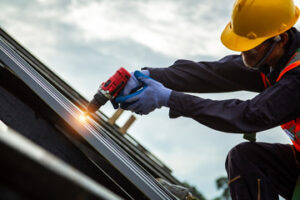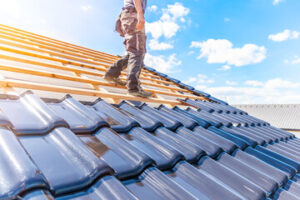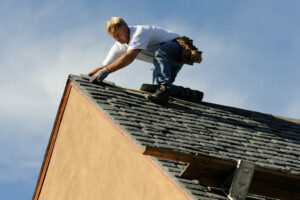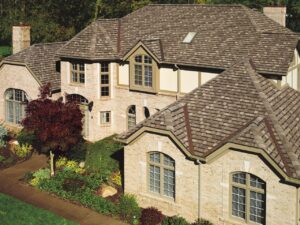Roofers install, replace, and repair roofs on residential and commercial buildings. They work with a variety of materials, including shingles, bitumen, and metal sheets.
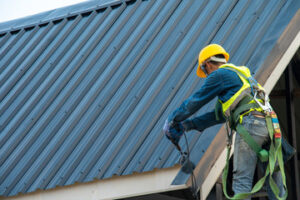
Do-it-yourself roofing projects can be dangerous and expensive, especially if you don’t have the right tools. A professional roofer has the specialized tools to do the job properly and safely. Visit Website to learn more.
Roofers install new roofs on commercial buildings, homes and other structures. Their duties include measuring the dimensions of the roof, cutting roofing materials and laying down underlayment. They may also attach shingles, tiles or metal panels to the underlayment. A top-tier roofer will install these elements with precision to ensure that the new roof is watertight and weatherproof.
A residential roofer typically works on single-family homes and multi-unit housing complexes. Their work requires them to navigate through residential neighborhoods, putting themselves at risk of being hit by speeding cars or other unforeseen circumstances. Roofers in this career must also interact with homeowners, discussing their options and answering any questions that they have.
Commercial roofers install more complex roofing systems. They often work with a team of specialists to complete these projects, which may involve installing solar reflective systems, energy-efficient coatings and photovoltaic cells to generate electricity. These types of systems are becoming more popular as they become more cost-effective and environmentally friendly.
Before a roofer can begin working on a structure, they must tear off the old roof. This task is dangerous because it involves climbing on the scaffolding or ladders and lifting heavy objects. It is important for roofers to follow all safety guidelines when performing this job and use tools like hammers, nail guns, shears and tin snips with extreme caution.
Once the old roof is torn off, the crew can begin installing the new one. Roofers will measure and cut roofing materials to fit the specific dimensions of each roof. They will then tack the material to the underlayment and apply sealant around all edges of the roof. They will also add any necessary ventilation and heating systems to the roof. Finally, the roofers will install any flashing around chimneys, vents, joints and valleys in the roof.
A high-quality roofer will use metal tin snips to trim off excess pieces of flashing and then carefully nail them into place. They will also replace any gutters or downspouts that are damaged or clogged with debris. A good roofer will take care of all the little details that make a house a home and keep its value up.
Repair
Roofers repair leaky roofs, re-shingle or re-tile damaged structures and replace skylight windows. They also fix rotten joists, repair lead sheeting and cladding and install insulation. They use a variety of hand tools including ladders, shears and tin snips. When repairing flashing, they attempt to match the way it was originally nailed or sealed. If nails are used, they try to avoid areas that will be exposed to water. They may use roof sealant or, if the structure is old and vulnerable, roofing cement to completely encase the flashing. This prevents water from seeping into the home.
Roofers often work at heights, so they use safety harnesses and equipment. They also use power tools such as saws and grinders.
Maintenance
Roofers maintain and repair the roofs of buildings. They use a variety of materials, including shingles and bitumen. Properly installed roofs keep water from leaking into buildings, damaging the interior, and compromising equipment or furnishings. They also prevent heat loss and help structures meet energy efficiency requirements. Roofers may specialize in either residential or commercial roofing, or both. Depending on their specialization, they may also perform other construction tasks such as carpentry or siding installation.
Some roofers, known as shinglers, focus on the installation of asphalt or fiberglass shingles. They are skilled in aligning and attaching shingles to create watertight and aesthetically pleasing roofs. Other roofers, called single-ply or metal roofers, work on flat or low-sloped roofs that are made of foam or metal. Roofers can also install insulation and vapor barriers.
Regardless of the type of roof they are working on, all roofers must follow health and safety guidelines when performing their duties. This is especially important since they are frequently working at heights and using heavy tools. They should be trained in the proper use of fall protection equipment and ladders.
Roofers should also be able to identify and repair problems with the structure of a roof, including leaks or deterioration. They can also fix gutters and downspouts, seal leaky joints and cracks, and replace or repair damaged shingles or flashing. In some cases, they may also clean debris from the roof and in the gutters.
A common type of roofer is a storm chaser, who travels to areas affected by severe weather and offers services related to insurance claims. This type of roofer must be able to communicate effectively with homeowners and insurers, as well as negotiate with contractors and other professionals who are working on the property. These roofers typically need to be licensed and bonded. Many states require this license in order to work as a roofer. It is also important to know that attempting large repairs without a professional can void your roof warranty. Inspecting your roof regularly can help you spot problems early, before they worsen and cause costly damage. A licensed roofer can advise you on the best maintenance schedule for your property.
Sales
In the world of roofing, salespeople are a vital part of the team. They are responsible for finding potential customers and working with them through the entire process, from initial inspection to signing contracts and paying their commission. Salespeople need to be comfortable quoting prices, discussing payment options and explaining the benefits of different roof types.
A successful roofing company will also employ a strong selling strategy that includes up-selling products and services, like gutters, ventilation, insulation and skylights. This will help the salespeople achieve their sales goals and boost company profits. Creating a sales training program and providing the proper tools will also help new roofing salespeople thrive.
Some roofers use a relationship-based approach to sell, which involves building rapport with homeowners and letting them know that they can trust them. These roofers often start their sales presentations by asking how the homeowner’s day is going and answering their questions. They may also suggest that the homeowner get together with both members of their household to discuss roofing options.
Other roofers work with a more traditional sales model and focus on price as their main selling point. These roofers typically present a variety of options to their prospects, starting with the highest-priced materials. They will then negotiate for the best pricing possible. Storm chasers are another type of roofing salesperson that follows major storms, knocking on doors and offering to inspect roof damage.
It can be beneficial for a roofing company to have a clear and transparent pricing structure, including the gross margin for each job. This metric is the amount charged to a customer minus the cost of the roofing materials and the pay for the roofers who perform the installation. By sharing this information with salespeople, it will encourage them to prioritize jobs that yield the highest gross profit and will ensure that they’re incentivized to make smart sales decisions that benefit the company.
